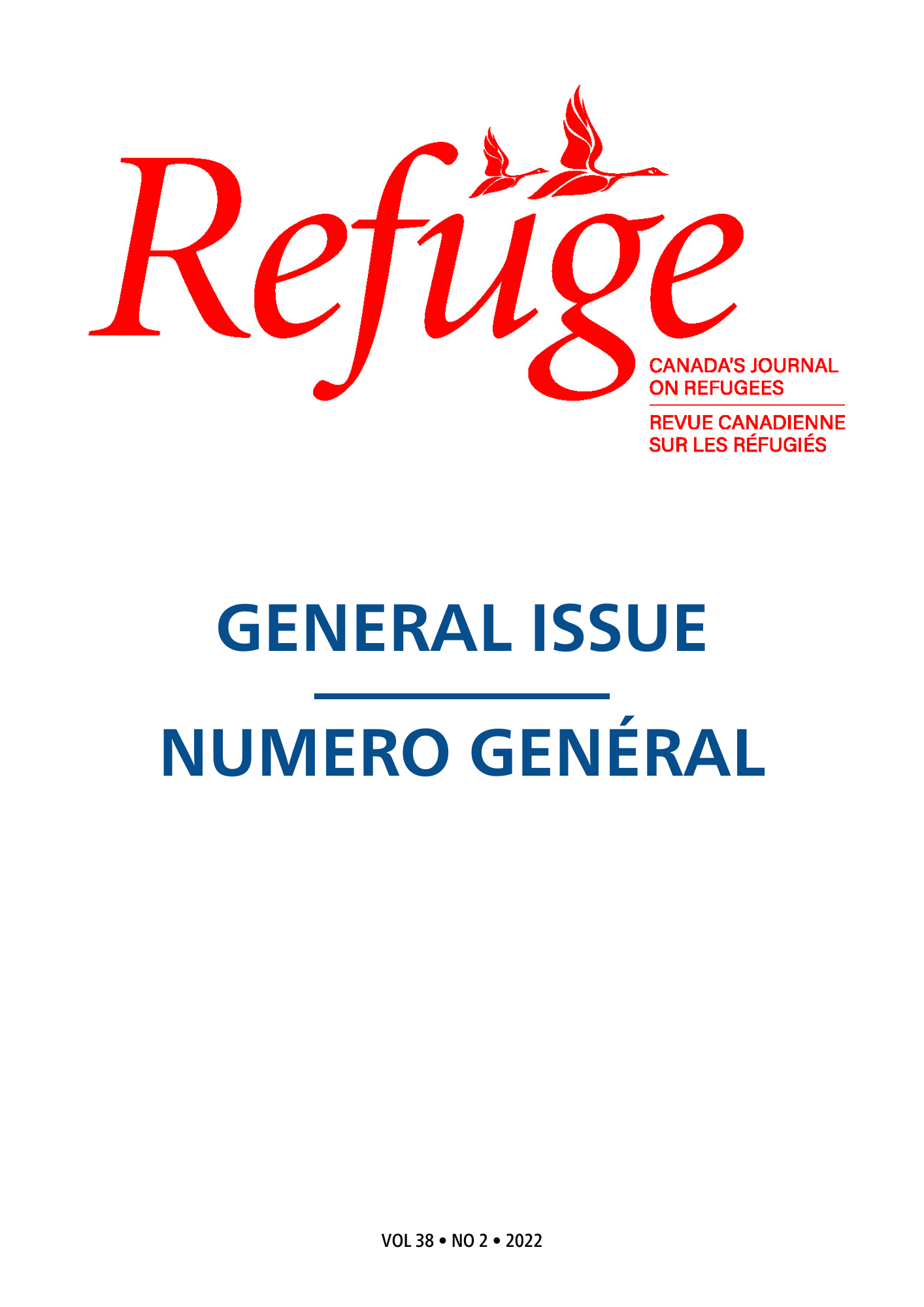Classe sociale et contexte d'asile : les parcours d'exil réfugié.e.s syrien.ne.s réinstallé.e.s au Canada
DOI:
https://doi.org/10.25071/1920-7336.40927Keywords:
Syrian Refugees, social class, forced migration, Canada, BourdieuAbstract
This article mobilizes a approach for analyzing the influence of social class on the exile pathways of 20 Syrian government assisted refugee (GARS) families who arrived in Canada between 2015 and 2016. Our results demonstrate the existence of heterogeneity in class positioning within the Syrian GARS category, specifically with respect to the ability to mobilize and convert various types of capital (economic, social and cultural) to access migration out of Syria while staying in the different asylum contexts of Turkey, Lebanon and Jordan.
Metrics
References
Agier, M. (2006). Le gouvernement humanitaire et la politique des réfugiés. Recueil Alexandries, 10. http://www.reseau-terra.eu/article569.html
Al-Kharabsheh, L., Al-Bazz, S., Koc, M., Garcia, J., Lane, G., Engler-Stringer, R., Lane, G., White, J. et Vatanparast, H. (2020). Household food insecurity and associated socio-economic factors among recent Syrian refugees in two Canadian cities. Border Crossing, 10(2), 203–214. https://doi.org/10.33182/bc.v10i2.1161
Ayoub, M. (2017). Gender, social class and exile: The case of Syrian women in Cairo. Dans J. Freedman, Z. Kivilcim et N. Ö. Baklacıoğlu (dir.), A gendered approach to the Syrian refugee crisis (p. 77–104). Routledge.
Baban, F., Ilcan, S. et Rygiel, K. (2017). Playing border politics with urban Syrian refugees. Movements. Journal for Critical Migration and Border Regime Studies, 3(2), 81-102. http://movements-journal.org/issues/05.turkey/01.atac,heck,hess,kasli,ratfisch,soykan,yilmaz--contested.borders.turkey.migration.regime.introduction.html
Bajwa, J. K., Abai, M., Kidd, S., Couto, S., Akbari-Dibavar, A. et McKenzie, K. (2018). Examining the intersection of race, gender, class, and age on post-secondary education and career trajectories of refugees. Refuge : Canada’s Journal on Refugees/Refuge : revue canadienne sur les réfugiés, 34 (2), 113-123. https://doi.org/10.7202/1055582ar
Bélanger, D., & Saraçoğlu, C. (2020). The governance of Syrian refugees in Turkey: The state-capital nexus and its discontents. Mediterranean Politics, 25(4), 413-432. https://doi.org/10.1080/13629395.2018.1549785
Bélanger, D., Ouellet, M., & Saraçoğlu, C. (2021). Syrian trajectories of exile in Lebanon and Turkey: Context of reception and social class. Population, Space and Place, 27(5), e2474. https://doi.org/10.1002/psp.2474
Bidet, J. (2018). Déplacements : Migrations et mobilités sociales en contexte transnational. Actes de la recherche en sciences sociales, 225(5), 67–82. https://doi.org/10.3917/arss.225.0067
Bourdieu, P. (1986). The forms of capital. Dans J. Richardson (dir.), Handbook of theory and research for the sociology of education (p. 241-258). Greenwood Press.
Bourdieu, P. et Wacquant, L. J. (1992). An invitation to reflexive sociology. University of Chicago press.
Bracking, S. (2003). Sending money home: Are remittances always beneficial to those who stay behind?. Journal of International Development, 15(5), 633–644. https://doi.org/10.1002/jid.1021
Bréant, H. (2015). (Im) mobilité internationale : les inégalités au sein des catégories populaires face à la migration. Lien social et Politiques, 74, 37-56. https://doi.org/10.7202/1034063ar
Canefe, N. (2018). Invisible lives: Gender, dispossession, and precarity amongst Syrian refugee women in the Middle East. Refuge : Canada’s Journal on Refugees/Refuge: revue canadienne sur les réfugiés, 34(1), 39-49. https://doi.org/10.7202/1050853ar
Card, D. et Raphael, S. (dir.). (2013). Immigration, poverty, and socioeconomic inequality. Russell Sage Foundation.
Castles, S. et Kosack, G. (1973). Immigrant workers and class structure in Western Europe. Oxford University Press.
Clark, C. R. (2007). Understanding vulnerability: From categories to experiences of young Congolese people in Uganda. Children & Society, 21(4), 284–296. https://doi.org/10.1111/j.1099-0860.2007.00100.x
Cohen, R. (1988). The new helots: Migrants in the international division of labour. Gower Publishing Company, Limited.
Dağtaş, S. (2018). Inhabiting difference across religion and gender: Displaced women’s experiences at Turkey’s border with Syria. Refuge: Canada’s Journal on Refugees/Refuge: revue canadienne sur les réfugiés, 34(1), 50-59. https://doi.org/10.7202/1050854ar
De Andrade, G. S. (2020). Beyond vulnerability: Syrian refugees in urban spaces in Turkey. International Journal for Crime, Justice and Social Democracy, 9(3), 34–46. https://doi.org/10.5204/ijcjsd.v9i3.1589
Doraï, K. (2015). Les Palestiniens et le conflit syrien. Parcours de réfugiés en quête d’asile au Sud-Liban. Revue européenne des migrations internationales, 31(3-4), 103-120. https://doi.org/10.4000/remi.7392
Dorai, K. (2018, 4 septembre). Conflict and migration in the Middle East: Syrian refugees in Jordan and Lebanon. E-International Relations.
Doraï, K. et Piraud-Fournet, P. (2018, 18 juillet). Self-settlement of Syrian refugees in Northern Jordan: A comparative study of Zaatari Refugee Camp and Azraq City. Structures of Protection: Rethinking Refugee Shelter. Oxford: https://halshs.archives-ouvertes.fr/halshs-01859774
Elrick, J. et Winter, E. (2018). Managing the national status group: Immigration policy in Germany. International Migration, 56(4), 19–32. https://doi.org/10.1111/imig.12400
Gowayed, H. (2019). Diverging by gender: Syrian refugees’ divisions of labor and formation of human capital in the United States. Gender & Society, 33(2), 251–272. https://doi.org/10.1177/0891243218819753
Gowayed, H. (2020). Resettled and unsettled: Syrian refugees and the intersection of race and legal status in the United States. Ethnic and Racial Studies, 43(2), 275–293. https://doi.org/10.1080/01419870.2019.1583350
Hamilton, L. K., Veronis, L. et Walton-Roberts, M. (dir.). (2020). A national project: Syrian refugee resettlement in Canada (Vol. 2). McGill-Queen’s University Press.
Hammar, A. (2014). The paradoxes of class: crisis, displacement and repositioning in post-2000 Zimbabwe. Dans A. Hammar (dir.), Displacement economies in Africa: paradoxes of crisis and creativity (p. 79–104). Zed Books.
Hanley, J., Al Mhamied, A., Cleveland, J., Hajjar, O., Hassan, G., Ives, N., Khyar, R. et Hynie, M. (2018). The social networks, social support and social capital of Syrian refugees privately sponsored to settle in Montreal: Indications for employment and housing during their early experiences of integration. Canadian Ethnic Studies, 50(2), 123–148. https://doi.org/10.1353/ces.2018.0018
Haugen, S. (2019). “We feel like we’re home”: the resettlement and integration of Syrian refugees in smaller and rural Canadian communities. Refuge : Canada’s Journal on Refugees/Refuge : revue canadienne sur les réfugiés, 35(2), 53-63. https://doi.org/10.7202/1064819ar
Hynie, M., McGrath, S., Bridekirk, J., Oda, A., Ives, N., Hyndman, J., Arya, N., Shakya, Y. B., Hanley, J. et McKenzie, K. (2019). What role does type of sponsorship play in early integration outcomes? Syrian refugees resettled in six Canadian cities. Refuge : Canada’s Journal on Refugees/Refuge: revue canadienne sur les réfugiés, 35(2), 36-52. https://doi.org/10.7202/1064818ar
Hyndman, J. et Giles, W. (2016). Refugees in extended exile: Living on the edge. Routledge.
Ilcan, S., Rygiel, K. et Baban, F. (2018). The ambiguous architecture of precarity: Temporary protection, everyday living and migrant journeys of Syrian refugees. International Journal of Migration and Border Studies, 4(1–2), 51–70. https://doi.org/10.1504/IJMBS.2018.091226
Immigration Refugees Citizenship Canada (n.d.). #Welcome Refugees: Key figures. Récupéré le 20 mai 2021 https://www.canada.ca/en/immigration-refugees-citizenship/services/refugees/welcome-syrian-refugees/key-figures.html
Janmyr, M. (2016). Precarity in exile: The legal status of Syrian refugees in Lebanon. Refugee Survey Quarterly, 35(4), 58–78. https://doi.org/10.1093/rsq/hdw016
Kagan, M. (2011, 1er février). “We live in a country of UNHCR”: The UN surrogate state and refugee policy in the Middle East. The UN Refugee Agency: Policy Development & Evaluation Service Research Paper No. 201, UNLV William S. Boyd School of Law Legal Studies Research Paper Series. https://papers.ssrn.com/sol3/papers.cfm?abstract_id=1957371
Kaida, L., Hou, F. et Stick, M. (2020). The long-term economic integration of resettled refugees in Canada: a comparison of Privately Sponsored Refugees and Government-Assisted Refugees. Journal of Ethnic and Migration Studies, 46(9), 1687–1708. https://doi.org/10.1080/1369183X.2019.1623017
Kivilcim, Z. (2017). Lesbian, gay, bisexual and transsexual (LGBT) Syrian refugees in Turkey. Dans J. Freedman, Z. Kivilcim et N. Ö. Baklacıoğlu (dir.), A gendered approach to the Syrian refugee crisis (p. 26–41). Routledge.
Kim, J. (2018). Migration-Facilitating Capital: A Bourdieusian Theory of International Migration. Sociological Theory, 36(3), 262–288. https://doi.org/10.1177/0735275118794982
Kleist, N. (2010). Negotiating respectable masculinity: Gender and recognition in the Somali diaspora. African Diaspora, 3(2), 185–206. https://doi.org/10.1163/187254610X526913
Kofman, E. (2018). Family migration as a class matter. International Migration, 56(4), 33–46. https://doi.org/10.1111/imig.12433
Lenner, K. et Turner, L. (2019). Making refugees work? The politics of integrating Syrian refugees into the labor market in Jordan. Middle East Critique, 28(1), 65–95. https://doi.org/10.1080/19436149.2018.1462601
Lokot, M. (2018). Syrian refugees: thinking beyond gender stereotypes. Forced Migration Review, 57, 33–35. https://www.fmreview.org/syria2018/lokot
Lubkemann, S. C. (2008). Involuntary immobility: On a theoretical invisibility in forced migration studies. Journal of Refugee Studies, 21(4), 454–475. https://doi.org/10.1093/jrs/fen043
McSpadden, L. (1999). Contradictions and control in repatriation: Negotiations for the return of 500,000 Eritrean refugees. Dans R. Black & K. Koser (dir.), The end of the refugee cycle? Refugee repatriation and reconstruction (p. 69–84). Berghahn Books.
Myrttinen, H., Khattab, L. et Maydaa, C. (2017). “Trust no one, beware of everyone”: Vulnerabilities of LGBTI refugees in Lebanon. Dans J. Freedman, Z. Kivilcim et N. Ö. Baklacıoğlu (dir.), A gendered approach to the Syrian refugee crisis (p. 61–76). Routledge.
Oliver, C. et O’Reilly, K. (2010). A Bourdieusian analysis of class and migration: Habitus and the individualizing process. Sociology, 44(1), 49–66. https://doi.org/10.1177/0038038509351627
Operational Data Portal. (n.d.). Syrian Regional Refugee Response. https://data2.unhcr.org/en/situations/syria
Oudshoorn, A., Benbow, S. et Meyer, M. (2019). Resettlement of Syrian refugees in Canada. Journal of International Migration and Integration, 21(3), 893-908. https://doi.org/10.1007/s12134-019-00695-8
Pearlman, W. (2020). Host state engagement, socioeconomic class, and Syrian refugees in Turkey and Germany. Comparative Politics, 52(2), 241–272. https://doi.org/10.5129/001041520X15681326148598
Però, D. (2014). Class politics and migrants: Collective action among new migrant workers in Britain. Sociology, 48(6), 1156–1172. https://doi.org/10.1177/0038038514523519
Portes, A. (2010). Migration and social change: Some conceptual reflections. Journal of Ethnic and Migration Studies, 36(10), 1537–1563. https://doi.org/10.1080/1369183X.2010.489370
Prothmann, S. (2018). Migration, masculinity and social class: Insights from Pikine, Senegal. International Migration, 56(4), 96–108. https://doi.org/10.1111/imig.12385
Rajaram, P. K. (2018). Refugees as surplus population: Race, migration and capitalist value regimes. New Political Economy, 23(5), 627–639. https://doi.org/10.1080/13563467.2017.1417372
Ritchie, G. (2018). Civil society, the state, and private sponsorship: the political economy of refugee resettlement. International Journal of Lifelong Education, 37(6), 663–675. https://doi.org/10.1080/02601370.2018.1513429
Sanyal, R. (2018). Managing through ad hoc measures: Syrian refugees and the politics of waiting in Lebanon. Political Geography, 66, 67–75. https://doi.org/10.1016/j.polgeo.2018.08.015
Şimşek, D. (2020). Integration processes of Syrian refugees in Turkey: “Class-based integration”. Journal of Refugee Studies, 33(3), 537–554. https://doi.org/10.1093/jrs/fey057
Sinatti, G. (2014). Masculinities and intersectionality in migration: transnational Wolof migrants negotiating manhood and gendered family roles. Dans T.-D. Truong, D. Gasper, J. Handmaker, & S. I. Bergh (dir.), Migration, gender and social justice (p. 215–226). Springer.
Turner, L. (2015). Explaining the (non-) encampment of Syrian refugees: security, class and the labour market in Lebanon and Jordan. Mediterranean politics, 20(3), 386–404. https://doi.org/10.1080/13629395.2015.1078125
Turner, L. (2020). “# Refugees can be entrepreneurs too!” Humanitarianism, race, and the marketing of Syrian refugees. Review of International Studies, 46(1), 137–155. https://doi.org/10.1017/S0260210519000342
Turner, L. (2021). The politics of labeling refugee men as “vulnerable”. Social Politics: International Studies in Gender, State & Society, 28(1), 1–23. https://doi.org/10.1093/sp/jxz033
Van Hear, N. (2006). “I went as far as my money would take me”: conflict, forced migration and class. Dans F. Crepeau, D. Nakache, M. Collyer, N. Goetz, A. Hansen, R. Modi, A. Nadig, S. Spoljar-Vrzina et M. Willigen (dir.). Forced migration and global processes: A view from forced migration studies (p. 125–158). Lexington Books.
Van Hear, N. (2014). Reconsidering migration and class. International Migration Review, 48(1_suppl), 100–121. https://doi.org/10.1111/imre.12139
Walton-Roberts, M., Veronis, L., Blair, C. et Dam, H. (2020). A tale of three mid-sized cities: Syrian refugee resettlement and a progressive sense of place. Dansn L. K. Hamilton, L. Veronis, et M. Walton-Roberts (dir.), A national project: Syrian refugee resettlement in Canada (Vol. 2) (p. 243-267). McGill-Queen’s University Press.
Wringe, A., Yankah, E., Parks, T., Mohamed, O., Saleh, M., Speed, O., Hémono, R., Relyea, B., Ibrahim, M., Sandhu, J. S. et Scott, J. (2019). Altered social trajectories and risks of violence among young Syrian women seeking refuge in Turkey: a qualitative study. BMC women’s health, 19(1), 1–8. https://doi.org/10.1186/s12905-019-0710-9
Published
How to Cite
Issue
Section
License
Copyright (c) 2022 Myriam Ouellet, Danièle Bélanger

This work is licensed under a Creative Commons Attribution-NonCommercial 4.0 International License.
Refuge authors retain the copyright over their work, and license it to the general public under the Creative Commons Attribution-Non Commercial License International (CC BY-NC 4.0). This license allows for non-commercial use, reproduction and adaption of the material in any medium or format, with proper attribution. For general information on Creative Commons licences, visit the Creative Commons site. For the CC BY-NC 4.0 license, review the human readable summary.







